#Cable Market
Text
HV & EHV Underground Cables Market Report, Demand, Key Vendors, Segment, Growth Opportunities by 2017 to 2032
Overview: The HV & EHV Underground Cables Market is a segment of the electrical power industry that focuses on the production and distribution of high voltage (HV) and extra high voltage (EHV) underground cables. These cables are designed to transmit electricity at higher voltage levels underground, providing efficient and reliable power transmission and distribution. HV & EHV Underground Cables Market, Global Outlook and Forecast by 2029, at a CAGR of 4.9% during the forecast period(2023-2029)
The HV & EHV Underground Cables Market has been experiencing significant growth in recent years, driven by the increasing demand for efficient and reliable electricity transmission and distribution infrastructure. HV and EHV underground cables offer advantages such as reduced transmission losses, improved power quality, and reduced environmental impact compared to overhead transmission lines.
Trends and Growth Drivers:
Increasing Energy Demand: The growing global energy demand, driven by population growth and industrialization, has led to the expansion of power transmission and distribution networks. HV and EHV underground cables enable efficient and secure power transmission over long distances, supporting the growth of the market.
Renewable Energy Integration: The integration of renewable energy sources, such as wind and solar power, into the electricity grid requires efficient transmission infrastructure. HV and EHV underground cables play a vital role in transmitting renewable energy from remote generation sites to load centers, facilitating the integration of clean energy sources.
Urbanization and Undergrounding Initiatives: The increasing urbanization and aesthetic concerns have led to undergrounding initiatives, where overhead power lines are replaced with underground cables. This trend is driving the demand for HV and EHV underground cables in urban areas, improving the visual impact and reducing the risk of power outages due to weather-related incidents.
Technological Advancements: Ongoing technological advancements in cable design and materials are driving the growth of the HV & EHV underground cables market. These advancements focus on enhancing cable performance, increasing transmission capacity, improving insulation properties, and reducing installation and maintenance costs.
Industry Analysis: The HV & EHV Underground Cables Market is characterized by the presence of major cable manufacturers and suppliers operating globally. Market participants offer a wide range of HV and EHV underground cables, including XLPE (cross-linked polyethylene) and MI (mass-impregnated) cables, tailored to meet the specific requirements of power transmission and distribution projects.
The market is highly competitive, with a focus on product innovation, quality assurance, and project execution capabilities. Collaboration between cable manufacturers, power utilities, and engineering firms is common to ensure seamless integration and reliable performance of underground cable systems.
Demand Outlook: The demand for HV and EHV underground cables is expected to witness substantial growth in the coming years. Factors such as increasing energy demand, renewable energy integration, urbanization trends, and technological advancements drive the market.
Additionally, government initiatives promoting undergrounding of power infrastructure, grid modernization efforts, and investments in smart city projects contribute to the market's growth potential. The need for reliable and resilient power transmission and distribution infrastructure further fuels the demand for HV and EHV underground cables.
In conclusion, the HV & EHV Underground Cables Market is experiencing significant growth due to the increasing demand for efficient and reliable power transmission and distribution infrastructure. Trends such as renewable energy integration, urbanization, and technological advancements drive the market. Collaborations and government initiatives further contribute to the market's expansion.
We recommend referring our Stringent datalytics firm, industry publications, and websites that specialize in providing market reports. These sources often offer comprehensive analysis, market trends, growth forecasts, competitive landscape, and other valuable insights into this market.
By visiting our website or contacting us directly, you can explore the availability of specific reports related to this market. These reports often require a purchase or subscription, but we provide comprehensive and in-depth information that can be valuable for businesses, investors, and individuals interested in this market.
“Remember to look for recent reports to ensure you have the most current and relevant information.”
Click Here, To Get Free Sample Report: https://stringentdatalytics.com/sample-request/hv-&-ehv-underground-cables-market/9736/
Market Segmentations:
Global HV & EHV Underground Cables Market: By Company
• Prysmian Group
• Nexans
• Southwire
• Hengtong Group
• Furukawa Electric
• Sumitomo Electric Industries
• Qrunning Cable
• LS Cable & System
• Taihan Electric
• Riyadh Cable
• NKT Cables
Global HV & EHV Underground Cables Market: By Type
• HV
• EHV
Global HV & EHV Underground Cables Market: By Application
• Direct Current
• Alternative Current
Global HV & EHV Underground Cables Market: Regional Analysis
All the regional segmentation has been studied based on recent and future trends, and the market is forecasted throughout the prediction period. The countries covered in the regional analysis of the Global HV & EHV Underground Cables market report are U.S., Canada, and Mexico in North America, Germany, France, U.K., Russia, Italy, Spain, Turkey, Netherlands, Switzerland, Belgium, and Rest of Europe in Europe, Singapore, Malaysia, Australia, Thailand, Indonesia, Philippines, China, Japan, India, South Korea, Rest of Asia-Pacific (APAC) in the Asia-Pacific (APAC), Saudi Arabia, U.A.E, South Africa, Egypt, Israel, Rest of Middle East and Africa (MEA) as a part of Middle East and Africa (MEA), and Argentina, Brazil, and Rest of South America as part of South America.
Visit Report Page for More Details: https://stringentdatalytics.com/reports/hv-&-ehv-underground-cables-market/9736/
Reasons to Purchase HV & EHV Underground Cables Market Report:
Comprehensive Insights: Market research reports provide in-depth and comprehensive insights into the ULSFO market. They typically cover various aspects such as market size, growth trends, competitive landscape, regulatory environment, technological developments, and consumer behavior. These reports offer a holistic view of the market, saving time and effort in gathering information from multiple sources.
Data and Statistics: Market research reports often include reliable and up-to-date data and statistics related to the ULSFO market. This data can help in analyzing market trends, understanding demand and supply dynamics, and making informed business decisions. Reports may include historical data, current market figures, and future projections, allowing businesses to assess market opportunities and potential risks.
Market Segmentation and Targeting: Market research reports often provide segmentation analysis, which helps identify different market segments based on factors such as vessel type, application, end-users, and geography. This information assists businesses in targeting specific customer segments and tailoring their marketing and business strategies accordingly.
Competitive Analysis: Market research reports typically include a competitive analysis section that identifies key players in the ULSFO market and evaluates their market share, strategies, and product offerings. This information helps businesses understand the competitive landscape, benchmark their performance against competitors, and identify areas for differentiation and growth.
Market Trends and Forecast: Market research reports provide insights into current market trends and future forecasts, enabling businesses to anticipate changes in the ULSFO market. This information is valuable for strategic planning, product development, investment decisions, and identifying emerging opportunities or potential threats in the market.
Decision-Making Support: Market research reports serve as a valuable tool in decision-making processes. The comprehensive insights, data, and analysis provided in the reports help businesses make informed decisions regarding market entry, expansion, product development, pricing, and marketing strategies. Reports can minimize risks and uncertainties by providing a solid foundation of market intelligence.
About US:
Stringent Datalytics offers both custom and syndicated market research reports. Custom market research reports are tailored to a specific client's needs and requirements. These reports provide unique insights into a particular industry or market segment and can help businesses make informed decisions about their strategies and operations.
Syndicated market research reports, on the other hand, are pre-existing reports that are available for purchase by multiple clients. These reports are often produced on a regular basis, such as annually or quarterly, and cover a broad range of industries and market segments. Syndicated reports provide clients with insights into industry trends, market sizes, and competitive landscapes. By offering both custom and syndicated reports, Stringent Datalytics can provide clients with a range of market research solutions that can be customized to their specific needs
Contact US:
Stringent Datalytics
Contact No - +1 346 666 6655
Email Id - [email protected]
Web - https://stringentdatalytics.com/
#Cable Market#Underground Cable Installation#Cable Accessories#Cable Protection#HV Cable Industry Trends#EHV Cable Market Analysis.
0 notes
Text
Fuck it I’m joining in on the manifestation train; We got new promo cards, a new promo video, AND episode titles. If no trailer or clip comes out this weekend I will kill my current fave
#*in a trying-to-encourge-a-toddler-voice-* c’mon ninjago marketing i believe in you#you can do it i believe in you!!!!#ninjago#lego ninjago#ninjago dragons rising#dragons rising#cable stupids#cable rants#ninjago dr#m’beggin i’m beggin yoouuuu#put your loving trailer out darling#i listen to this song way to much hgghnnm please i need something to fuel me
69 notes
·
View notes
Text
Big Telco’s fury over FCC plan to infuse telecoms policy with facts
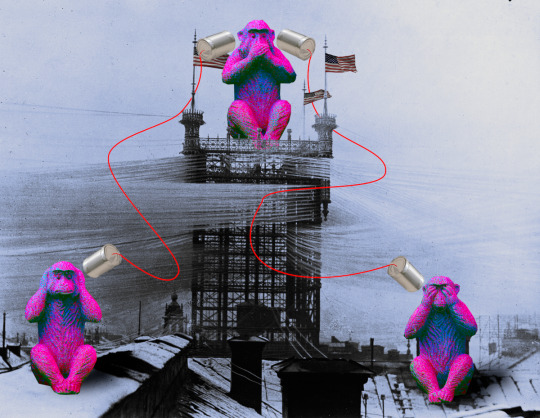
I'll be at the Studio City branch of the LA Public Library on Monday, November 13 at 1830hPT to launch my new novel, The Lost Cause. There'll be a reading, a talk, a surprise guest (!!) and a signing, with books on sale. Tell your friends! Come on down!

Reality has a distinct anti-conservative bias, but conservatives have an answer: when the facts don't support your policies, just get different facts. Who needs evidence-based policy when you can have policy-based evidence?
Take gun violence. Conservatives tell us that "an armed society is a polite society," which means that the more guns you have, the less gun violence you'll experience. To prevent reality from unfairly staining this pristine ideological mind-palace with facts, conservatives passed the Dickey Amendment, which had the effect of banning the CDC from gathering stats on American gun-violence. No stats, no violence!
https://en.wikipedia.org/wiki/Dickey_Amendment
Policy-based evidence is at the core of so many cherished conservative beliefs, like the idea that queer people (and not youth pastors) are responsible for the sexual abuse of children, or the idea that minimum wages (and not monopolies) decrease jobs, or the idea that socialized medicine (and not private equity) leads to death panels:
https://pluralistic.net/2023/04/26/death-panels/#what-the-heck-is-going-on-with-CMS
The Biden administration features a sizable cohort of effective regulators, whose job is to gather evidence and then make policy from it:
https://pluralistic.net/2023/10/23/getting-stuff-done/#praxis
Fortunately for conservatives, not every Biden agency is led by competent, honest brokers – the finance wing of the Dems got to foist some of their most ghoulish members upon the American people, including a no-fooling cheerleader for mass foreclosure:
https://pluralistic.net/2023/03/06/personnel-are-policy/#janice-eberly
And these same DINOs reached across the aisle to work with Republicans to keep some of the most competent, principled agency leaders from being seated, like the remarkable Gigi Sohn, targeted by a homophobic smear campaign funded by the telco industry, who feared her presence on the FCC:
https://pluralistic.net/2023/03/19/culture-war-bullshit-stole-your-broadband/
The telcos are old hands at this stuff. Long before the gun control debates, Ma Bell had figured out that a monopoly over Americans' telecoms was a license to print money, and they set to corrupting agencies from the FCC to the DoJ:
https://pluralistic.net/2021/11/14/jam-to-day/
Reality has a vicious anti-telco bias. Think of Net Neutrality, the idea that if you pay an ISP for internet service, they should make a best effort to deliver the data you request, rather than deliberately slowing down your connection in the hopes that you'll seek out data from the company's preferred partners, who've paid a bribe for "premium delivery."
This shouldn't even be up for debate. The idea that your ISP should prioritize its preferred data over your preferred data is as absurd as the idea that a taxi-driver should slow down your rides to any pizzeria except Domino's, which has paid it for "premium service." If your cabbie circled the block twice every time you asked for a ride to Massimo's Pizza, you'd be rightly pissed – and the cab company would be fined.
Back when Ajit Pai was Trump's FCC chairman, he made killing Net Neutrality his top priority. But regulators aren't allowed to act without evidence, so Pai had to seek out as much policy-based evidence as he could. To that end, Pai allowed millions of obviously fake comments to be entered into the docket (comments from dead people, one million comments from @pornhub.com address, comments from sitting Senators who disavowed them, etc). Then Pai actively – and illegally – obstructed the NY Attorney General's investigation into the fraud:
https://pluralistic.net/2021/05/06/boogeration/#pais-lies
The pursuit of policy-based evidence is greatly aided by the absence of real evidence. If you're gonna fill the docket with made-up nonsense, it helps if there's no truthful stuff in there to get in the way. To that end, the FCC has systematically avoided collecting data on American broadband delivery, collecting as little objective data as possible:
https://pluralistic.net/2020/05/26/pandemic-profiteers/#flying-blind
This willful ignorance was a huge boon to the telcos, who demanded billions in fed subsidies for "underserved areas" and then just blew it on anything they felt like – like the $45 billion of public money they wasted on obsolete copper wiring for rural "broadband" expansion under Trump:
https://pluralistic.net/2022/02/27/all-broadband-politics-are-local/
Like other cherished conservative delusions, the unsupportable fantasy that private industry is better at rolling out broadband is hugely consequential. Before the pandemic, this meant that America – the birthplace of the internet – had the slowest, most expensive internet service of any G8 country. During the lockdown, broadband deserts meant that millions of poor and rural Americans were cut off from employment, education, health care and family:
https://pluralistic.net/2021/02/12/ajit-pai/#pai
Pai's response was to commit another $8 billion in public funds to broadband expansion, but without any idea of where the broadband deserts were – just handing more money over to monopoly telcos to spend as they see fit, with zero accountability:
https://pluralistic.net/2020/05/26/pandemic-profiteers/#flying-blind
All that changed after the 2020 election. Pai was removed from office (and immediately blocked me on Twitter) (oh, diddums), and his successor, Biden FCC chair Jessic Rosenworcel, started gathering evidence, soliciting your broadband complaints:
https://pluralistic.net/2021/03/23/parliament-of-landlords/#fcc
And even better, your broadband speed measurements:
https://pluralistic.net/2021/04/14/for-sale-green-indulgences/#fly-my-pretties
All that evidence spurred Congress to act. In 2021, Congress ordered the FCC to investigate and punish discrimination in internet service provision, "based on income level, race, ethnicity, color, religion, or national origin":
https://www.congress.gov/117/plaws/publ58/PLAW-117publ58.pdf
In other words, Congress ordered the FCC to crack down on "digital redlining." That's when historic patterns of underinvestment in majority Black neighborhoods and other underserved communities create broadband deserts, where internet service is slower and more expensive than service literally across the street:
https://pluralistic.net/2021/06/10/flicc/#digital-divide
FCC Chair Rosenworcel has published the agency's plan for fulfilling this obligation. It's pretty straightforward: they're going to collect data on pricing, speed and other key service factors, and punish companies that practice discrimination:
https://www.fcc.gov/document/preventing-digital-discrimination-broadband-internet-access
This has provoked howls of protests from the ISP cartel, their lobbying org, and their Republican pals on the FCC. Writing for Ars Technica, Jon Brodkin rounds up a selection of these objections:
https://arstechnica.com/tech-policy/2023/11/internet-providers-say-the-fcc-should-not-investigate-broadband-prices/
There's GOP FCC Commissioner Brendan Carr, with a Steve Bannon-seque condemnation of "the administrative state [taking] effective control of all Internet services and infrastructure in the US. He's especially pissed that the FCC is going to regulate big landlords who force all their tenants to get slow, expensive from ISPs who offer kickbacks to landlords:
https://www.fcc.gov/document/carr-opposes-bidens-internet-plan
The response from telco lobbyists NCTA is particularly, nakedly absurd: they demand that the FCC exempt price from consideration of whether an ISP is practicing discrimination, calling prices a "non-technical aspect of broadband service":
https://www.fcc.gov/ecfs/document/110897268295/1
I mean, sure – it's easy to prove that an ISP doesn't discriminate against customers if you don't ask how much they charge! "Sure, you live in a historically underserved neighborhood, but technically we'll give you a 100mb fiber connection, provided you give us $20m to install it."
This is a profoundly stupid demand, but that didn't stop the wireless lobbying org CTIA from chiming in with the same talking points, demanding that the FCC drop plans to collect data on "pricing, deposits, discounts, and data caps," evaluation of price is unnecessary in the competitive wireless marketplace":
https://www.fcc.gov/ecfs/document/1107735021925/1
Individual cartel members weighed in as well, with AT&T and Verizon threatening to sue over the rules, joined by yet another lobbying group, USTelecom:
https://www.fcc.gov/ecfs/document/1103655327582/1
The next step in this playbook is whipping up the low-information base by calling this "socialism" and mobilizing some of the worst-served, most-gouged people in America to shoot themselves in the face (again), to own the libs:
https://pluralistic.net/2022/12/15/useful-idiotsuseful-idiots/#unrequited-love

If you'd like an essay-formatted version of this post to read or share, here's a link to it on pluralistic.net, my surveillance-free, ad-free, tracker-free blog:
https://pluralistic.net/2023/11/10/digital-redlining/#stop-confusing-the-issue-with-relevant-facts

Image:
Japanexperterna.se (modified)
https://www.flickr.com/photos/japanexperterna/15251188384/
CC BY-SA 2.0:
https://creativecommons.org/licenses/by-sa/2.0/
--
Mike Mozart (modified)
https://www.flickr.com/photos/jeepersmedia/14325839070/
https://www.flickr.com/photos/jeepersmedia/14325905568/
https://www.flickr.com/photos/jeepersmedia/14489390566/
www.ccPixs.com
https://www.flickr.com/photos/86530412@N02/8210762750/
CC BY 2.0
https://creativecommons.org/licenses/by/2.0/
#pluralistic#reality-based community#willful ignorance#digital redlining#telecoms#isps#cable company fuckery#net neutrality#network neutrality#fcc#monopolies#market failures#musketfuckers#ammosexuals#guns#race#reality has an anti-conservative bias#dickey amendment#policy based evidence#facts don't care about your feelings
137 notes
·
View notes
Text

On the market, tasting Adam's apple...
#ai generated#wool sweater#cable knit#ai image#hand knitted#knit sweater#turtleneck#ai man#ai sexy#handsome guy#market#apples#Adam
15 notes
·
View notes
Text
THE IPOD IS WORKING
I REPEAT
THE IPOD
IS WORKING
#OKAY CONTEXT A FEW MONTHS AGO I BOUGHT AN IPOD CLASSIC‚ THE A1238 MODEL FROM 2007 TO BE EXACT#ON THE FLEA MARKET FOR THREE EUROS#THIS BAD BABY IS CAPABLE OF STORING EIGHTY GIGS OF MUSIC ON IT#TROUBLE IS‚ I WAS IN TOO MUCH SHIT TO GO LOOKING FOR A CABLE I COULD ATTEMPT TO CHARGE IT WITH#(the people at the flea market in my hometown are usually very honest about whether or not a piece of tech is working but i'll always have#my doubts until i see for myself)#TODAY I FINALLY MANAGED TO BRING MYSELF TO GO TO MY FAVORITE TECH STORE AND AFTER SOME DIGGING THEY ACTUALLY FOUND A 30-PIN CABLE#(it took them a while because the younger of the two dudes who were in the shift didn't exactly know what he was looking for. he brought a#package to the older guy and he said ''that's a samsung cable.'' in his defense‚ that cable and the actual 30-pin are incredibly similar in#shape so i don't blame him lmao‚ it was an honest mistake)#and i plugged that bad boy in tonight and NOT ONLY IS IT GIVING SIGNS OF LIFE (CHARGING)‚ IT SENT ME RIGHT TO THE MENU SCREEN AS SOON AS IT#GOT TO A CERTAIN PERCENTAGE!!!!! HOLY SHIT!!!!!!!!!!!!!!!!!!!!!!!!!!!!#NOW I FINALLY HAVE THE MOTIVATION TO GO THROUGH MY ENTIRE YOUTUBE DOC AND EXTRACT EVERY SINGLE SONG I'VE LISTENED TO IN THE PAST THREE YEAR#(that's as far as they date the watch history logs‚ sadly - they start deleting them after some point so everything before late 2020 is los#to time‚ but fortunately enough there is PLENTY left!)#CAN I GET A HELLLLLL YEEEEEEEEEAAAAAAAAAAAAAHHHHHHHHHHHHHHHHHH BABYYYYYYYYYYYYYYYYYYYYYY#logs#I AM IMMEASURABLY HAPPY ABOUT THIS AAAAAAAAAAAAAAAAAAAAAAA
10 notes
·
View notes
Text


#found a tiny friend at the flea market today !!!#need to do some research (can't even find the model lol) and hunt down a cable to check if he still works (probably not)#i don't think this type of broadcasting is still in use but if i can get static on it that'd be so fun#i love my new tiny son he's got vibes#vintage tech
2 notes
·
View notes
Text
Hello everybody my name is welcome (welcome (welcome (welcome (welcome))))
#portuguese#markiplier#market flier#fiber optic cable#had ruined my life#please tell me yall know what I'm talking about
4 notes
·
View notes
Text

Go to link👈☑️
#welcome homejob#news#job news#us news#world news#cable news#news channel#news station#finance news#business news#breaking news#news ]#cbs news#22news#financial news#stock market news#news 8#news 3#global news#job market#job opening#news at 5#news at 6#fox news#abc7 news#news at 10#news at 11#tech news#fox54 news#local news
4 notes
·
View notes
Note
ok im not in the storm hawks fandom literally dont even know what that show is but i thought you were fucking kidding when you said the main plot is dark enough to be on par with game of thrones until you reblogged that unnerving trivia post like wtf this was a kids show?!?!?
This show was only a kids show because the networks wanted it to be. It could've been an R-rated sci-fi/fantasy series about the horrors of war by just taking itself more seriously. Easily.
#Storm Hawks#of all the kids shows to get pearl-clutchy over they sure picked a doozy huh?#though iirc I'm pretty sure it was marketed as a *family* show#which is very different from a *kids* show#but I could be wrong it's been years I don't even have cable anymore#teens humping? a cardinal sin you need to burn in hell for#pseudo-cannibalism and using corpses as power-displays? that's fine kids love that shit#the only reason my works are more ''problematic'' than canon#is because I am an adult making content for other adults so I actually *show* the fucked up stuff instead of just alluding to it#but I'm sorry rape happens in war#and this is a show about war#it is genuinely not that big a stretch to say Mr. Moss probably got handsy with Aerrow when he was in the prison#'cause hey buddy guess what tends to happen to prisoners of war!!#keep in mind this show came out in 2007 when they would rerun goosebumps every October#so this was back when networks thought kids could have a little horror#as a treat#ngl we need to bring that back because I firmly believe introducing kids to age-appropriate horror helps media literacy
5 notes
·
View notes
Text
I just got a Taco Bell ad that was a full minute long and it was unskippable.
Taco Bell, you make me want to set myself ablaze.
#Taco Bell#from a marketing perspective the ad itself wasn’t even good#it was such a bland nothing ad#definitely relied too heavily on the last 3 seconds where the brand name is revealed#beyond that#it’s obviously bullshit to have an unskippable ad of that length on YouTube#on the off chance I’m watching cable at my family’s house I don’t care about commercials#but on YouTube???#you get 30 seconds match and if I can’t skip in the first 15 seconds I’m pissed#anyway stupid rant
2 notes
·
View notes
Photo
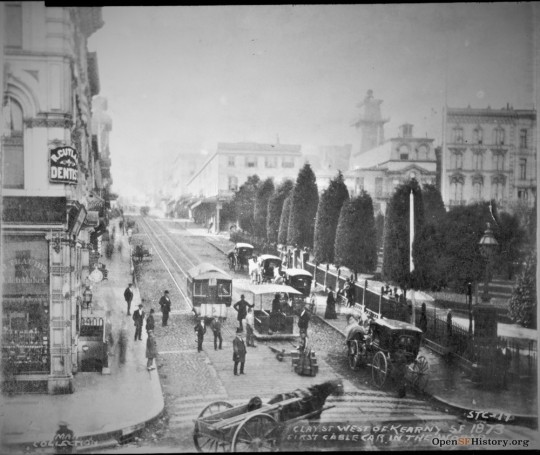
"Clay St. West of Kearny SF 1873 - First Cable Car in the World"
In this elevated view west on Clay Street to the Clay St. Cable RR cable car at Kearny Street Terminus, Portsmouth Square can be seen on the right. Signage for the R. Cutlar Dentist, H. Traube watchmaker and jeweler at left. This photo is a detail from Carleton Watkins' stereo card number 2368 (Variant) under the original title: "Clay St. Hill R.R., San Francisco, Cal. Run by A.S. Hallidie's patent Endless Steel Wire Rope and Gripping Attachment. Overcomes an Elevation of 307 feet in a length of 2800 feet. Worst grade, one foot in six" (from the Marilyn Blaisdell Collection). The photo is also notable as one of the very few photographs showing a pre-1906 Chinese resident in the same frame as a cable car.
Chinatown at the Advent of the Cable Car
This year San Francisco marks the sesquicentennial of its cable car system. In the late 19th century, San Francisco experienced rapid urbanization and faced the challenge of its hilly terrain. Traditional horse-drawn streetcars struggled to navigate the steep inclines, necessitating an innovative transportation solution.
In the predawn hours of August 2, 1873, Andrew Smith Hallidie introduced the first successful cable car system in the world. The cable cars utilized an underground cable mechanism to propel the cars along tracks, overcoming the city's hilly landscape. This new mode of transportation revolutionized urban mobility and played a pivotal role in San Francisco's development.

California and Montgomery streets, c. 1889. Photographer unknown (from the Martin Behrman Negative Collection / Courtesy of the Golden Gate NRA, Park Archives). The view is west on California across Montgomery, as an Omnibus Railway Co. horsecar #11 passes the Parrott Building, or Parrott Block (1852, Architect Stephen Williams) seen in background. A Chinese man is walking south at the northeast corner of the intersection. The signs for the offices of Equitable Life and Dr. William F. McNutt at 405 Montgomery are visible at right.
The introduction of cable cars in San Francisco had a profound impact on the Chinese community. Several cable car lines conveniently passed through Chinatown, allowing Chinese residents to access transportation. The cable cars provided a reliable means of travel for the community, connecting them to other neighborhoods and employment opportunities initially for domestic workers serving the mansions atop Nob Hill and eventually throughout the city.

Clay Street Cable Car, c. 1873. Photograph by Carleton Watkins and published as “Pacific Coast. 2369″ and by Taber Photo (from the Marilyn Blaisdell collection). In this startling image, patrons and car operators can be seen posing on or alongside cable cars on Clay near Jones Street, except for at least two Chinese men seated in the car at left. Their faces were lost to history because one man placed his hat over his face, while the other inclined his head to avoid the camera’s lens. Watkins' image may be the only extant image showing urban pioneer Chinese actually riding an early cable car, possibly to their jobs as domestic servants for the mansions on Nob Hill.
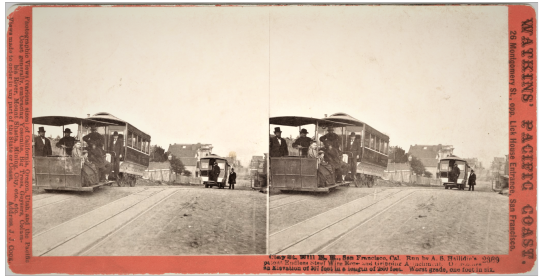
Watkins' stereo card bears the legend: “Clay Street Hill R.R., San Francisco, Cal. Run by A.S. Hallidie's patent Endless Steel Wire Rope and Gripping Attachment. Overcomes an Elevation of 307 feet in a length of 2800 feet. Worst grade, one foot in six. 2369” Photograph by Carleton E. Watkins (from the collection of the San Francisco Public Library).

“At the Corner of Dupont and Jackson Streets” c. 1896 -1906. Photograph by Arnold Genthe (from the Genthe photograph collection, Library of Congress, Prints and Photographs Division). A cable car on the Jackson Street line can be seen at right. “Two girls wearing embroidered holiday wear are crossing the street,” as historian Jack Tchen wrote in his book about Genthe’s Chinatown photos. “The store behind them is a ‘Chinese and Japanese Curios’ store located at 924 Dupont Street, southwest corner. The good-quality, expensive vases in the window display and the sign in English indicate that the store catered especially to tourists. Some such stores were owned by Japanese, but the main reason that both Chinese and Japanese goods were sold in the same store was that the general public could not distinguish between the two cultures.” (NOTE: Tchen’s location of the address at 924 Dupont appears incorrect, as the photo depicts the west or odd-numbered side of the street. The building bearing an address of 943 Dupont actually occupied the southwest corner of the intersection with Jackson Street. Directories of the time indicate that the Tong Yuen Lai confectionary operated at the 943 address during the 1890’s. By the 1905 publication of the Chinatown phone directory, the Jong Mee Cigar Store had either co-located or operated solely at the address.)
The cable cars, particularly the Clay, Sacramento, California, and Jackson street lines, had played a significant role in fostering economic growth within Chinatown.

“B 3096 Clay Street Hill, Chinatown, San Francisco” c. 1886. Photograph by Isaiah West Taber (from the Marilyn Blaisdell Collection). In this view east on the south side of Clay Street, and just above Dupont, the trees of Portsmouth Square can in the distance at left, a horsecar can be seen on Kearny and an original Clay Street cable car. The large billboard for Globe Business College and Conservatory of Music in distance. The large vertical sign in Chinese denotes an herbalist or apothecary store.

The view east on Clay Street, c. 1888. (Photographer unknown from the collection of the California Historical Society). A cable car is in the process of crossing Dupont Street and heading west up the hill. The balconies of the Yoot Hong Low restaurant appear at left.

“161 Street Scene in Chinatown,” no date. Photographer unknown (from a private French collection). A cable car can be seen traveling west on Clay passing Stockton Street.

“Chinese Quarter, San Francisco, Cal.” c. 1891. Photograph by A.J. McDonald (from a private collection). A cable car is seen passing the 800-block of Clay Street between Dupont St. and Waverly Place. The decorated balconies of the Yoot Hong Low restaurant can be seen at center.

“B 2807 Lotta’s Fountain, and junction of Market, Kearny a& Geary Streets, S.F.” c. late 1880s. Photograph by Isaiah West Taber (from a private collection). A Market Street Cable Rail car appears in the right foreground. Two Chinese men can be seen in the background at left on the sidewalk between the two lampposts and under the Philadelphia Lager sign.

“Carrying New Year Presents” c. 1900-1905. Photograph by Arnold Genthe (from the Genthe photograph collection, The Library of Congress, Prints and Photographs Division). A cable car can be seen on the hill just behind the head of the young woman in the photo. She appears to have been a servant to the family of prominent merchant Lew Kan. The boy in the photo is Lew Bing Yuen, the older son, who also appears in Genthe’s well-known photo “Children of the High Class.”
After transformation of post-1906 Chinatown into the “Oriental City,” this urban transit network remained crucial the neighborhood’s integration with the citywide economy. Tourists and locals utilized the cable car system, and Chinese-owned businesses along, and in proximity to, the cable car lines experienced increased patronage. This urban mobility represented by the cable car system, even after its reduction to only two lines, has sustained the Chinese community from it pioneer beginnings to this day.
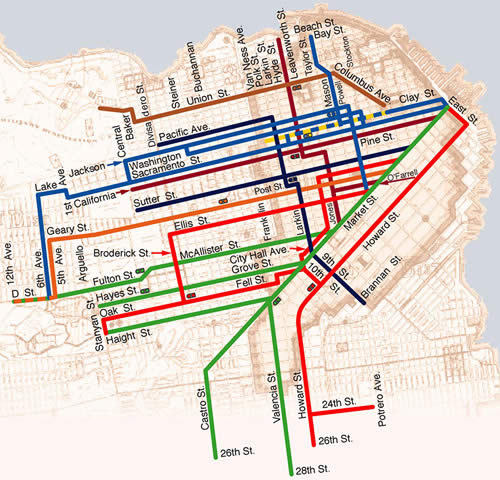
“San Francisco Cable Car Lines at the Fullest Extent of Operation (1890s)” (courtesy of the Cable Car Museum). As the Cable Car Museum advises here, “Clay Street Hill Railroad was the sole cable car company for 4 years. A former horsecar company, Sutter Street Railroad, developed its own version of Hallidie's patented system and began cable service in 1877, followed by California Street Cable Railroad -1878, Geary Street, Park & Ocean Railroad -1880, Presidio & Ferries Railroad -1882, Market Street Cable Railway -1883, Ferries & Cliff House Railway -1888, and Omnibus Railroad & Cable Company -1889.” At its peak, the San Francisco companies had laid “53 miles of track stretching from the Ferry Building to the Presidio, to Golden Gate Park, to the Castro, to the Mission.”
For the Chinese families who began to populate the eastern slopes of Nob and Russian Hills (and the garment workers in the small sewing factories along Pacific Avenue west of Stockton Street), the cable cars served as their principal transit system until the establishment of bus routes such as the Pacific Avenue shuttle (championed by Phil Chin and his Chinatown Transportation Improvement Project crew a half-century ago), and now known as the no. 12 Folsom/Pacific line.

A group of women (at least one of whom has bound feet) disembarks from a cable car in 1908. Photographer unknown (from the collection of the Chinese Historical Society of America). For women with bound feet (including great grandmothers on both sides of my family), the cars represented not only convenience but a necessary travel option for the residents navigating the hilly topography of San Francisco Chinatown.
The clang of cable car bells and the snap of the cable in the tracks remain an integral part of the soundtrack for the several generations of Chinese children who grew up in the greater Chinatown area.
Cable cars symbolized the vital role of urban transportation in fostering connections and opportunities -- providing convenient travel options for the residents of Chinatown, maintaining the neighborhood’s economy during hard times, and tying the segregated Chinese community to the larger city.
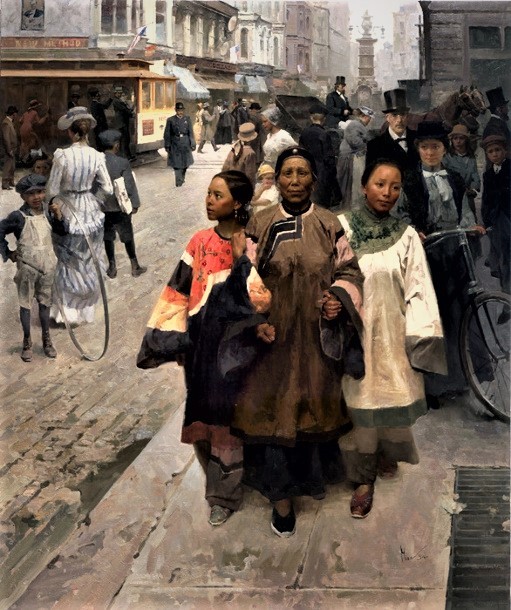
“Convergence of Cultures” oil painting by Mian Situ.
[updated 2023-8-14]
#Chinatown and the cable cars#Chinese riding 1873 cable car#Carleton Watkins#Andrew Hallidie#Clay Street cable car line#Chinatown Transportation Improvement Project#Lew Kan#Lew Bing Yuen#Sacramento Street cable car line#Jackson Street cable car line#Market Street Cable Rail line
4 notes
·
View notes
Text
youtube
AI used for good, four days before San Francisco 1906 earthquake. I worked for some companies on Market Street when I lived there many years ago. Not this many years ago, circa early 1990s for me. 
Fascinating time for different modes of transportation.
#ai film restoration#san francisco#1906#market street#modes of transportation#horses#buggies#automobiles#cable cars#pedestrians#history#denis shiryaev#Youtube
2 notes
·
View notes
Text
i swiped left on like 70 ppl, only swiped right on 4. i legit get such negative vibes from using dating apps that i deleted before getting any matches

#im a real creature#i'll get thru this lads 💪#market is so saturated with normies tho and man i just cant#after experiencing real fun talking with ppl abt your real (niche) interests i cant go back to feigning normie shit#so many ppl on there who like sports and watch cable tv UHGHNNGH#i just wanna be myself
2 notes
·
View notes
Text
Discover the Best of Hong Kong in One Day: Top Attractions, Food, and Culture
Experience the vibrant energy of Hong Kong in just one day! Start your day with a traditional dim sum breakfast at one of the city’s famous tea houses. Then, take a scenic tram ride up to Victoria Peak for stunning panoramic views of the city skyline. Next, head to the iconic Tian Tan Buddha statue on Lantau Island and marvel at the impressive 34-meter tall bronze figure. After lunch, explore the…

View On WordPress
#Avenue of Stars#Big Buddha#Central#city tour#Hong Kong#Lan Kwai Fong#Ngong Ping Cable Car#one day trip#Po Lin Monastery#Sky Terrace#Star Ferry#Temple Street Night Market#The Peak Tram#tourist attractions#travel#Tsim Sha Tsui#Victoria Harbour#Victoria Peak
2 notes
·
View notes
